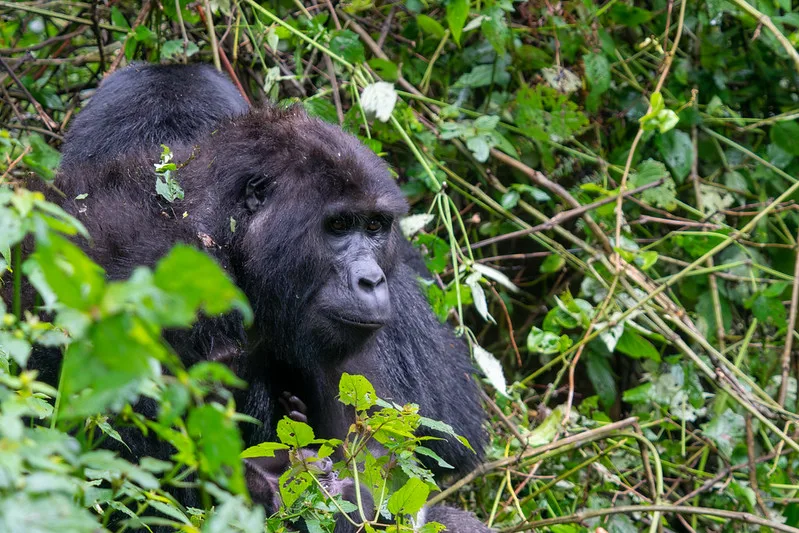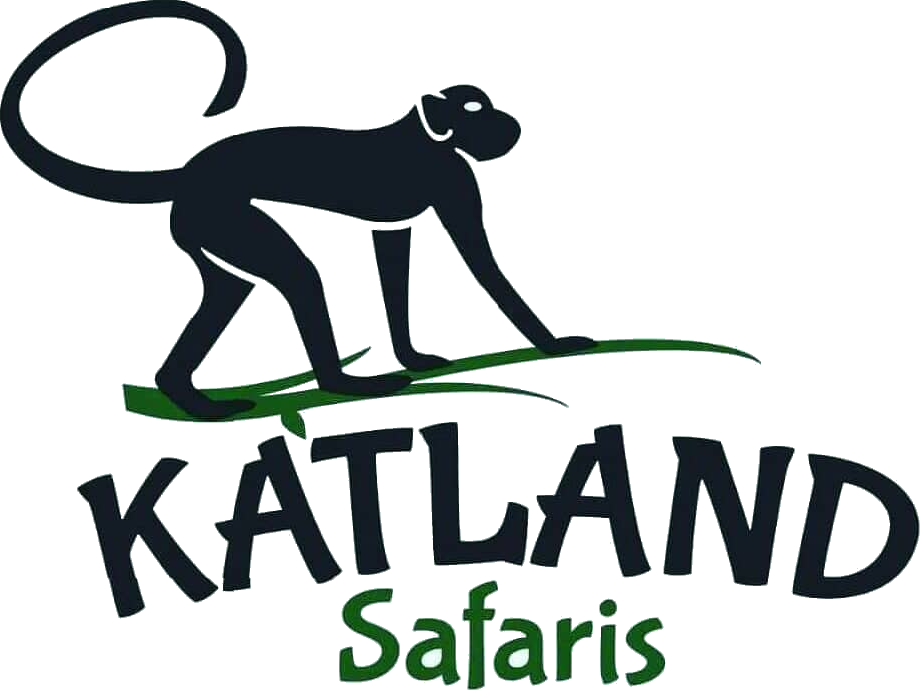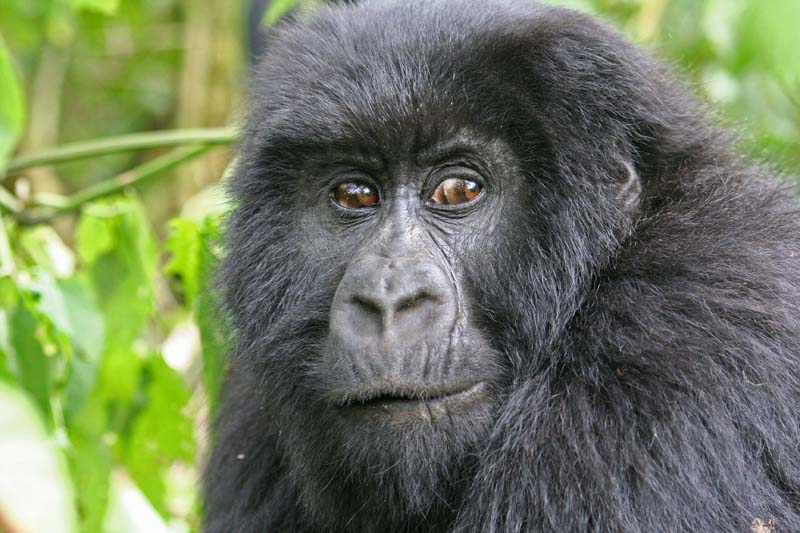Frequently Asked Questions about Bwindi Impenetrable National Park.
Research some often asked concerns about Bwindi Impenetrable National Park. Perfect woodland in South Western Uganda is Bwindi Impenetrable National Park. Thick and this is whence it gets its name Bwindi—here is the habitat of the surviving mountain gorillas. Locally the Bakiga refer to the forest as “Bwindi,” meaning impenetrable and definitely appropriate for this twofold meaning.
One travels 530 miles on the route from Kampala, the capital of Uganda, arriving after around eight hours without stopping.
Although the major activity in this old park is gorilla trekking, it is a wildlife refuge having been one of the ice age survivors. Among the many primates who love the offerings of Bwindi forest, Black and white colobus, blue monkeys, olive baboons, L’Hoest’s, red-tailed monkeys, and chimpanzees come first.
Other wild creatures that call Bwindi Forest home include warthogs, duikers, Giant Forest pigs, and forest elephants.
Since this is the main birding site in Uganda and Africa, birding without Bwindi National impenetrable Park is incomplete. On the IUCN red list, Bwindi impenetrable National Park has about 23 of 26 Albertine endemics among around 350 bird species.
Issues with Bwindi Impenetrable National Park
Bwindi Impenetrable Forest is located where?
East Africa Uganda has the Bwindi Impenetrable National Park. It is found in southwest Uganda. The park was split into two halves northern Bwindi and Southern Bwindi for management reasons; it holds the most remaining mountain gorillas thus.
The park is located 1160 meters to 2607 meters above sea level. One of the adventures of Bwindi Impenetrable National park is trekking to find mountain gorillas.
About 2390 mm of rain falls in Bwindi Forest annually from all directions of the earth. Temperatures of the Bwindi Impenetrable National park range from 7 degrees Celsius to -20 degrees Celsius.
Activities In Bwindi Impenetrable National Park
Trekking Under Gorillas
The attraction of Bwindi Impenetrable forest national park is gorilla treking. Though offered based on the location, a Gorilla Trekking permit lets you see the mountain gorillas. There are four gorilla trekking sites in the Bwindi forest; the main administrative region is the Buhoma area; the Ruhijah area, Rushaga area, Nkuringo area Gorilla families in each region are walked by a maximum of eight daily customers.
Birding in the Forest of Bwindi
The main place people go birdwatching in Uganda and Africa is Bwindi The woodland welcomes about 350 different bird species, including Albertine endemics. Every day, keen birders have an opportunity to find more than one hundred different species.
The list is large; some birds include Western Green Tinkerbird, Mountain Masked, Chestnut-throated Apalis, African Hill Babbler, Collared Apalis, Rwenzori Batis, and white-tailed Crested Fly Catcher.
For eager birders, Ruhija gorilla trekking region is a great part of Bwindi. For birding in Uganda, the true gem is the Mubwindi Swamp.
Primate Path In Bwindi
Apart from the mountain gorillas, Bwindi forest supports various other primates like chimpanzees, black and white colobus, blue monkeys, grey-cheeked mangabey, vervet monkeys, red-tailed monkeys. The list is unbounded.
A natural stroll in the national park Bwindi Forest
Anyone wanting in a stroll in Bwindi forest, including Munyanga river route immediately below Buhoma, has several options for tails to suit their needs for seeing birds and many primates.
Waterfall tail travels past tree ferns traversing lovely falls.
The greatest place to appreciate the western rift valley and get a fantastic perspective of Lake Edward and Rwenzori mountains on a clear bright day is Rushura Hill Trail.
Rising from the top of Rukubira hill, Muzabajiro loop tail offers the most amazing perspective of Bwindi Canopy, Virunga Volcanoes in Mgahinga National Park and western Rift Valley.
Walks through the Bwindi Community
Some community walks are utilized to guide visitors into the community so they may participate in the mountain gorilla conservations effort as they get benefits. Proceeded are utilized to assist community needs such road upkeep, school upgrades, better water supply, name but a few. Among the communal walks are several like:
Buhoma Community Walk and Cultural Event
By means of the local authorities of the Buhoma region, a three-hour walk allows visitors to learn about daily lives of the people. Time off is taken by visitors to the nearby banana brewer, to visit a local house, to have a chance with a traditional healer, and to watch a planned local dance group performance as the day ends.
Nkuringo Community Walk
For interested customers, the residents of the Nkuringo region arrange a community tour so you may meet a local blacksmith, home hold owner, brewer, and traditional healer. This is one approach to encourage community park cooperation as, even when the gorillas are misbehaving, the residents feel the need of informing the Authority rather than just killing them.
Getting to Bwindi Impenetrable National Park via road
Road traffic offers many more routes from Kampala, the primary city. Public transportation is accessible to everyone coming to Bwindi, however the stopovers are so numerous. You can find yourself late in the Bwindi region, but even your goods might have been lost. For such reasons, we advise against public transportation as you are heading to Bwindi for a Gorilla Trekking.
Kampala via Kabale to Kanungu to Buhoma
One travels roughly six hours for 414 kilometers from Kampala Main City to Kabale. Through Kanungu and Kanyantorogo, a constant drive wound a twisting marram road for around 150 kilometers.
Queen Elizabeth National Park via Kihihi to Buhoma
After a wildlife safari trip in Queen Elizabeth National Park, heading for gorilla trekking takes around five hours to reach Bwindi Impenetrable Forest; this is if you travel via Ishasha sector. About 160km from Mweya and 64 km from Ishasha sector lies Bwindi Impenetrable National Park. Tree climbing lions call Ishasha home, hence you need ensure the Ishasha Bridge is in excellent condition.
Kampala via Ntungamo to Rukungiri to Kihihi to Buhoma.
Your driving journey takes roughly eight hours without pauses. You may utilize this straight path while leaving Kampala. About 390 miles head, travel on the turmac road to Rukungiri for a murram road for 82km late hours of the evening simply to check in and relax.
Kampala from Kabale to Ruhijah through Buhoma
Following this path brings you 95 kilometers from distant Kabale to Rujiha. The road system is quite deteriorated.
From Kampala to Kabale then Nkuringo
On a twisting murram road, driving from Kabale to Nkuringo takes around 250 miles in about four hours.
One might choose to stop in Kisoro even have lodging here before gorilla trekking. Kabale to Kisoro is eighty kilometers driven. Driving from Kisoro to the NKuringo gorilla trekking location is 35 kilometers; one may sleep in Kisoro drive early morning to conduct gorilla trekking the following day. This trip takes one hour and thirty minutes or so.
Domestic daily flights run by Air to Bwindi Impenetrable National Park Kajjansi Air Strip and Entebbe Airport fly to Kihihi Airstrip in the morning and afternoon. Since most times the flights are over booked, particularly during the busiest seasons, you must reserve a seat ahead of time. One may arrange charter flights upon demand as well.
Given Kihihi Airstrip’s approximately one hour and thirty minute distance from the park headquarters, be sure to arrange a book transfer car.
The Ideal Park for Gorilla Trekking Bwindi Volcanoes National Park Or Impenetrable National Park
Though experience in both is amazing, the Bwindi Forest Versus Volcanoes Park gorilla trekking topic continues resurfaced. Because of its large size, Bwindi National Park offers a range of gorilla trekking families unlike those of Volcanoes, so you have many options. Though Volcanoes National Park may not be as big as Bwindi, its gorilla families are really appealing.
Although the Bwindi gorilla trekking permit is $800 per person, the road trip to Bwindi from Entebbe takes around eight hours. Though the duration and distance from Kigali airport is around two hours and half, Volcanoes National Park gorilla trekking permits cost $ 1500 per person.
Which lodging facility in Bwindi Impenetrable National Park
Anyone interested in Bwindi Activities include Gorilla Trekking, birdwatching, and Nature hikes can find a range of lodging in Bwindi Impenetrable National Park.
Where you sleep will depend on your budget. You may choose moderate, mid-range, or luxury hotel.
A few lodging options in Bwindi Impenetrable National Park include of
To list but a few, Clouds lodge, Gorilla Forest Lodge, Buhoma Lodge, Mahogany Springs, Gorilla Safari Lodge, Engage Lodge, Gorilla Resort, Bwindi View Bandas, Mantana Tented Camp, Lake Kitandara Camp, and Volcanoes Bwindi Camp.
What should one pack for the safari in Bwindi Impenetrable National park?
Following footwear that would help you find the mountain gorillas while trekking
a flash-less camera for capturing images and preserving memories of personally meeting the soft giants.
Rainproof gears will help you stay dry when it rains. The bwindi woodland gets rain without regard to time.
Long-sleeved pants and shirts in filthy pleasant hues to traverse the swampy wilderness
Even while most hotels offer, it’s advisable to bring your own just in case. Toiletries
Insect repellent as the woodland is home to many insects including stingers
Two binoculars can let one get a better view of forest inhabitants like birds and monkeys that could be up the extremely tall trees.
Visiting Bwindi Impenetrable National Park is best done when?
Open for visitors all year long, Bwindi impenetrable forest is well suited for gorilla trekking and birdwatching.
Because of the usable paths in the forest and less foliage particularly in view of gorilla trekking, the dry months June through September and December of Bwindi Forest are friendlier. Not quite marshy either is the terrain.
Contact KatlandSafaris for this and other often asked questions about Bwindi Impenetrable National Park.


